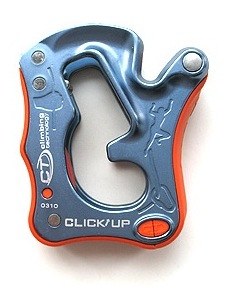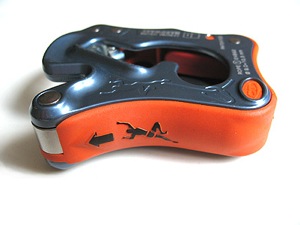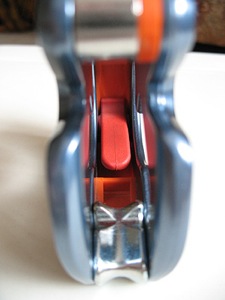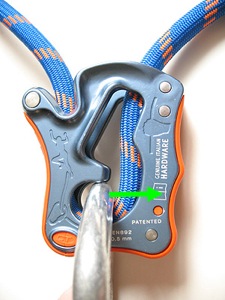Belay device Click-Up belongs to the group of semi-automatic belay devices or, as they are called sometimes, belay device with assisted braking. Which means, that the belaying, rope retention, must still do a person (belayer) with his hand, belay device will only help him/her with its blocking function. Within this group it belongs to the category of devices that use carabiners which are clipped to the belay devices for blocking of the rope. In the case of Click-Up is used HMS carabiner, which directly serves for attaching of the belay device to a seat harness. The principle of protection by this belay device is based on the fact that the rope inserted into the belay device is also clipped in the HMS carabiner and in case of heavy load the rope moves the carabiner into a position where carabiner presses the rope between itself and the belay device, thus stops, blocks or very strongly slows its movement.

By the fact, that the pressing of the rope is done directly by the carabiner connecting the belay device to the harness, we have the first noticeable difference between this type of belay device and other semi-automatic belay devices, which for this function use built-in metal cams. The difference is reduced volume and weight. Click-Up is small light semi-automatic belay device. By its design is in principle very similar to common “bucket”, and its operation is also very similar to it. This is nice because if you are growing habits while using “bucket” style belay device, you can transfer them in almost identical form to use of Click-Up, and vice versa when using Click-Up you will not learn any different habits that would complicate your use of dynamic tube style belay device.

Of course Click-Up, as well as all semi-automatic belay devices, is static belay device, which means it does not provide a dynamic rope slippage, which would lessen the impact force and stress on intermediate protection point, which arrest the fall. This is the reason why is Click-Up along with other semi-automatic belay devices predetermined for use on artificial walls, cultured rocks with plenty of drilled pitons (glue-in anchors) that have a strong intermediate points of protection close together. When climbing with the protection of chocks and other similar mobile belay devices is the use of Click-Up expressly not recommended by the manufacturer.
Click-Up belay device has basically a relatively simple structure. It is made of two lateral metal sidewalls, which are divided by a plastic filling. Both sidewalls and plastic filler are held together by several massive metal rivets.

In the sidewalls are opposite each other identical openings, which is the main principle of belay device function. They are specially shaped, and this shape determines the path of carabiner motion while blocking the rope. In one specific opening’s position the HMS carabiner serves only as a connection of the belay device to the harness, and we can move the rope through the belay device back and forth, as the leader needs. And in the second position, into which is the carabiner pulled by the stress on the rope, is taking place the blocking of the rope.
For proper function of Click-Up is therefore necessary to have a right size of other two components, a carabiner and rope, correctly fitting into the opening. Carabiner must have a regular upper arch, the manufacturer require use of only HMS carabiner, namely one which has a diameter of the body in its upper arch of 12 mm. On the market Click-Up manufacturer offers its own HMS carabiner, namely type Concept, but there is not a strict obligation to use this carabiner. Of course this carabiner is recommended by the manufacturer, but in the instructions of use, supplied with the product, is guaranteed that it will work with any other HMS carabiner; the only condition is that it has to have a 12 mm diameter of the body in the upper arch. The use of HMS carabiner of other dimensions or atypical profile of a cross-section of the carbine’s body may lead to slow slipping of a rope in a blocking position or accidental premature movement of carabiner into a blocking position. Therefore, when using some of your own HMS carabiners, we highly recommend measuring it and making sure that its body has the desired diameter. Rope used in a Click-Up it must have an average diameter ranging from 9 mm to 10.5 mm.

Click-Up must be also properly attached to the harness in order to work correctly. For this purpose there are symbols on the belay device showing where to attach HMS carabiner, which side of the plastic ridge has to be up and which one down, from where to where lead the rope to the leader, and where the rope has to lead to the belayer’s brake hand.
Parts of the belay device coming into intense contact with the rope are made of metal. The upper edge of the opening, from where the rope comes to the leader, is provided with a smooth metal roller.
The lower edge of the opening, from where the rope comes to the hand of belayer, is provided with a metal reinforcement in the form of curved rails with a profiled groove. Thanks to this there will be sufficient friction even if will be used thinner 9 mm rope.
As was already mentioned, the main principle of Click-Up function is the transition of HMS carabiner from one position in the opening to another. Therefore, there must be some way to hold the carabiner in the first position, without preventing it to move at the right moment into the second position. And this important function is provided by the only mechanical component of Click-Up. It is a small lifting lever, supported by flexible part. Stiffness of flexible part is set so that its force is sufficient enough to push the rope away during feeding to the leader or when retrieving. Volume of pushed-away or raised rope reduces the clearance of Click-Up opening, so HMS carabiner can not leave its position number one, and we can easily manipulate with the rope. However, once a greater force occurs (hangdogging of the leader, his/hers fall), the pull of the rope immediately and overwhelmingly overcomes resistance of flexible lifting lever, lever is pushed down and the HMS carabiner goes to a blocking position.
Continued in the book >>

